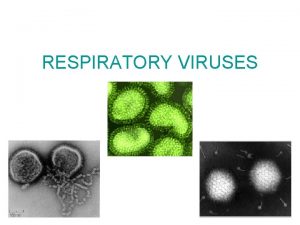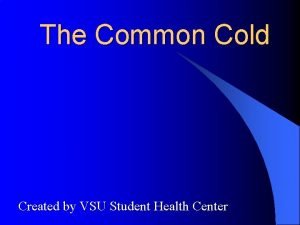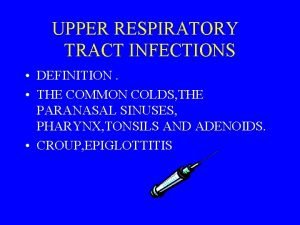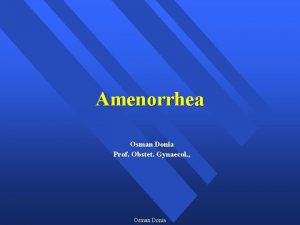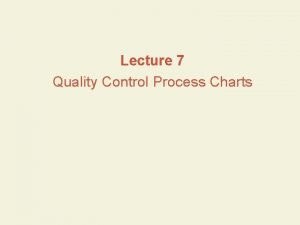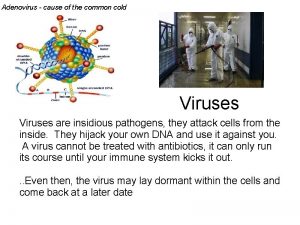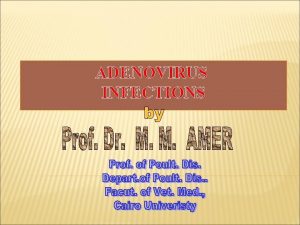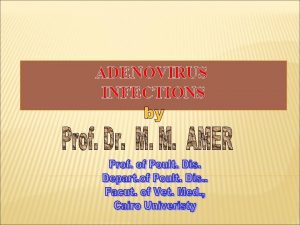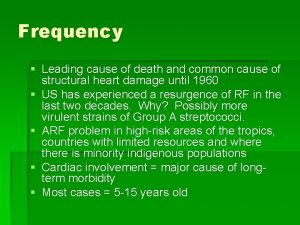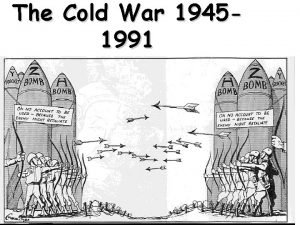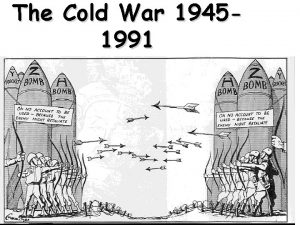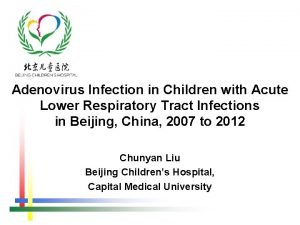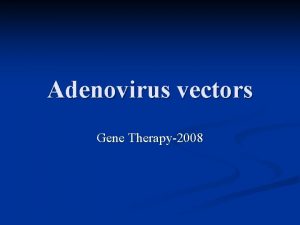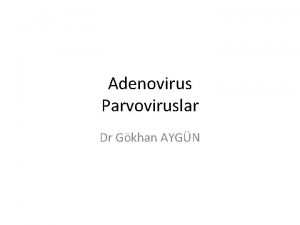Adenovirus cause of the common cold 19 3

































- Slides: 33

Adenovirus - cause of the common cold 19 -3 Viruses n n A virus is a particle of nucleic acid, protein, and sometimes lipids, that can reproduce only by infecting living cells – viruses DO NOT have all the characteristics of life and are not considered to be organisms Viruses are insidious pathogens that attack cells form the inside, hijack the DNA and use it against the host A virus cannot be treated with antibiotics and can only run its course until the immune system kicks it out (if it can)… …and even then, it may just be laying dormant to return at a later date


The Common Cold – What is it? n n n The common cold is a group of symptoms in the upper respiratory tract caused by a large number of different viruses Although more than 200 viruses can cause the common cold, the perpetrator is usually the rhinovirus, which is to blame for causing 10% to 40% of colds Also, the coronaviruses cause about 20% of colds

Corona Virus

What is the flu? n n Influenza (the flu) is a contagious respiratory illness caused by influenza viruses It can cause mild to severe illness, and at times can lead to death Each year in the United States on average, 5% to 20% of the population gets the flu; on average, more than 200, 000 people are hospitalized from flu-related complications, and about 36, 000 people die from flurelated causes There are many different types of flu virus, or “strains” that circulate from year to year and make people sick

Properties of Viruses n n n No membranes, cytoplasm, ribosomes, or other cellular components They cannot move, grow, or use energy They can only reproduce inside a host cell They consist of 2 major parts – a protein coat (capsid), and a core of hereditary material (DNA or RNA) They are extremely tiny, much smaller than a cell, and only visible with advanced electron microscopes Grouped by type of organism they infect (animal, plant, bacteria)

Virus Structure

Virus Types

Parasitic Nature n n n Obligate intracellular parasites – are only active inside a host cell & then only reproduce more viruses Specific to their hosts (human, dog, bacteria, etc. – some can cross species EX. Flu virus) They can only attack specific cells – the common cold is a virus that specifically attacks cells of the respiratory tract (hence the coughing and sneezing and sniffling), HIV specifically attacks white blood cells This is a bacteriophage, a type of virus that attacks bacteria. It is recognizeable because it looks like the lunar landing spaceship.

Viral Reproduction (Lytic Cycle and/or Lysogenic Cycle) n n n Lytic Cycle – Viral reproduction occurs, cells burst Lysogenic Cycle – Viral reproduction does not occur immediately (dormancy), viral DNA becomes part of host DNA (prophage) – not all viruses have a lysogenic cycle Viruses that undergo both cycles are described as virulent

n n Viruses multiply, or replicate using their own genetic material and the host cell's machinery to create more viruses. Viruses cannot reproduce on their own, and must infect a host cell in order to create more viruses. Typical Sequence of Virus Reproduction: 1. Attachment 2. Penetration – the virus injects its genetic material or is engulfed by the cell (virus enters lysogenic or lytic cycle) 3. Biosynthesis – viral components are made (capsid, enzymes, DNA/RNA) 4. Maturation – assembly of viral components 5. Release – viruses leave host cell to infect new cells (immediately or eventually destroys host cell)


Virus Life Cycle - General

See: http: //highered. mcgraw-hill. com/sites/007352543 x/student_view 0/chapter 20/lambda_phage_replication_cycle. html

Retroviruses – RNA viruses that have a DNA stage EX. Human Immunodeficiency Virus – causes AIDS n Retrovirus (RNA inside a protein coat) n Reverse transcriptase makes DNA from the virus RNA n DNA inserts into host DNA (prophage) n Proteins are assembled from the DNA code (protein synthesis) n Viruses are assembled from the proteins n Viruses are released from the cell

HIV (Human Immunodeficiency Virus)

HIV Life Cycle Video

Emerging Viruses n n Illnesses not previously known – AIDS, West Nile Virus, SARS, Ebola, Bird Flu Could be mutations of known viruses Could be viruses exposed when new areas were developed Could have jumped species

What is “swine” or “H 1 N 1” flu? Swine flu is a new strain of the flu virus that was first identified passing from human to human in 2009 n Because this particular virus had never circulated in human populations before, few had natural immunity n Many more people than were infected with this particular strain of the virus, although it did not turn out to be a particularly virulent strain n

Percentage of Visits for Influenza-like Illness (ILI) Reported by the U. S. Outpatient Influenza-like Illness Surveillance Network (ILINet), National Summary 2008 -2009 and Previous Two Seasons (Week ending 11 -14 -09)

Swine Flu Virus

Swine Flu Virus n n n Blue and Red “spikes” represent surface proteins Blue are hemagglutinin (HA) proteins Red are neuraminidase (NA) proteins

Flu Virus Names There are 16 types of HA protein and 9 types of NA protein n A flu virus has only one type of HA and one type of NA, so that is how they are named n Swine flu is grouped as an “H 1 N 1” virus because it has type 1 HA protein and type 1 NA protein n

Related to Viruses n n Viroids – even smaller than viruses, consist of RNA strands that lack a protein coat Prions – “rogue protein", believed to be the cause of Mad Cow Disease n http: //highered. mcgrawhill. com/sites/007352543 x/student_view 0/chapter 20/how_prions_arise. html

How do vaccines work? n Once you have gotten a virus, such as chicken pox, your body develops the immunity to that virus 1. Vaccines are made by growing a weakened or killed form of the virus (often grown in eggs) 2. This form of the virus is injected into a person's body, which causes an immune response (T and B cell activation), and immunity to that specific virus type n It is difficult to develop vaccines for retroviruses (HIV, influenza) because reverse transcriptase (RNA DNA) makes many random errors (mutations) which alters the virus enough so that the immune system does not recognize it

RV = rotovirus; DTa. P = diptheria, tetanus, pertussis (whooping cough); Hib = haemophilus influenza type B; PCV = pneumococcal vaccine; IPV = inactivated polio virus; MMR = measles, mumps, rubella,

Are vaccines safe? n n n A vaccine, like any medicine, could cause serious problems, such as a severe allergic reaction – but the risk is extremely small In most cases, the benefits of vaccination far outweigh the potential risks As a result of the vaccines discovered in the 20 th Century, parents and many healthcare providers of the 21 st Century have limited or no experience with the devastating effects of diseases such as polio, smallpox or measles. Fear of disease has shifted to concerns regarding vaccine safety. Scientific evidence has refuted many of the misconceptions regarding vaccine safety; however, parental refusal of vaccines is increasing.

Are vaccines safe? n The success of an immunization program depends on high rates of acceptance and coverage. n There is evidence of an increase in vaccine refusal in the United States and of geographic clustering of refusals that results in outbreaks. n Children with exemptions from school immunization requirements (a measure of vaccine refusal) are at increased risk for measles and pertussis and can infect others who are too young to be vaccinated, cannot be vaccinated for medical reasons, or were vaccinated but did not have a sufficient immunologic response.

Vaccine Success Story - Smallpox n n n Smallpox is a highly infectious, devastating, and disfiguring disease that is caused by variola virus Smallpox is characterized by numerous pustules containing infectious virus all over the body The fatality rate is more than one quarter of infected patients infected by the most serious form caused by Variola major

Vaccine Success Story - Smallpox n n n n The disease killed an estimated 400, 000 Europeans each year during the 18 th century Of all those infected, 20– 60% — and over 80% of infected children — died from the disease In the United States, from 1843 to 1855 first Massachusetts, and then other states required smallpox vaccination By 1897, smallpox had largely been eliminated from the United States In the early 1950 s an estimated 50 million cases of smallpox occurred in the world each year After successful vaccination campaigns throughout the 19 th and 20 th centuries, the WHO certified the eradication of smallpox in December 1979 The last cases of smallpox in the world occurred in an outbreak of two cases (one of which was fatal) in Birmingham, England in 1978

Vaccine Success Story - Polio n n n Polio is a viral disease, usually affecting children and young adults, caused by any of three polioviruses Polio virus causes inflammation of the motor neurons of the brain stem and spinal cord Symptoms include motor paralysis, followed by muscular atrophy and often permanent deformities Polio was one of the most dreaded childhood diseases of the 20 th century Polio epidemics have crippled thousands of people, mostly young children; the disease has caused paralysis and death for much of human history

Vaccine Success Story - Polio n n n By 1910, much of the world experienced a dramatic increase in polio cases and frequent epidemics became regular events, primarily in cities during the summer months These epidemics left thousands of children and adults paralyzed The polio vaccines developed by Jonas Salk in 1952 and Albert Sabin in 1962 are credited with reducing the global number of polio cases per year from many hundreds of thousands to around a thousand

Links n n http: //learn. genetics. utah. edu/content/be gin/cells/scale/ http: //www. xvivo. net/zirus-antivirotics/
 Parranda grippi ppt
Parranda grippi ppt Life cycle of adenovirus
Life cycle of adenovirus Welcome 1 unit 10 lesson 1
Welcome 1 unit 10 lesson 1 The causes of cold war
The causes of cold war Causes and effects of the korean war
Causes and effects of the korean war Greylag goose egg-retrieval behavior
Greylag goose egg-retrieval behavior Proximate causation vs ultimate causation
Proximate causation vs ultimate causation Learned behavior biology
Learned behavior biology Ter thin client
Ter thin client Common cold
Common cold Ophthalmootorhinolaryngology
Ophthalmootorhinolaryngology Common cold
Common cold Cushing syndrome most common cause
Cushing syndrome most common cause Common cause of buffer overflow cross-site scripting
Common cause of buffer overflow cross-site scripting Primary amenorrhea most common cause
Primary amenorrhea most common cause Bruxisml
Bruxisml Boys body
Boys body Common cause variation is
Common cause variation is Lowest common factor
Lowest common factor Lcm for 4 and 12
Lcm for 4 and 12 Multiples of 18 and 24
Multiples of 18 and 24 Common anode and common cathode
Common anode and common cathode Multiples of 9 and 21
Multiples of 9 and 21 Factor tree for 56
Factor tree for 56 Thiếu nhi thế giới liên hoan
Thiếu nhi thế giới liên hoan Khi nào hổ mẹ dạy hổ con săn mồi
Khi nào hổ mẹ dạy hổ con săn mồi điện thế nghỉ
điện thế nghỉ Biện pháp chống mỏi cơ
Biện pháp chống mỏi cơ Một số thể thơ truyền thống
Một số thể thơ truyền thống Trời xanh đây là của chúng ta thể thơ
Trời xanh đây là của chúng ta thể thơ Slidetodoc
Slidetodoc Bảng số nguyên tố
Bảng số nguyên tố Phối cảnh
Phối cảnh Các châu lục và đại dương trên thế giới
Các châu lục và đại dương trên thế giới

